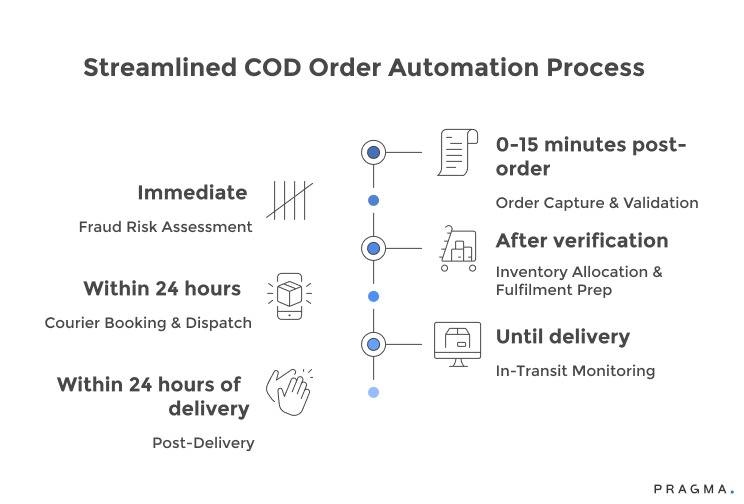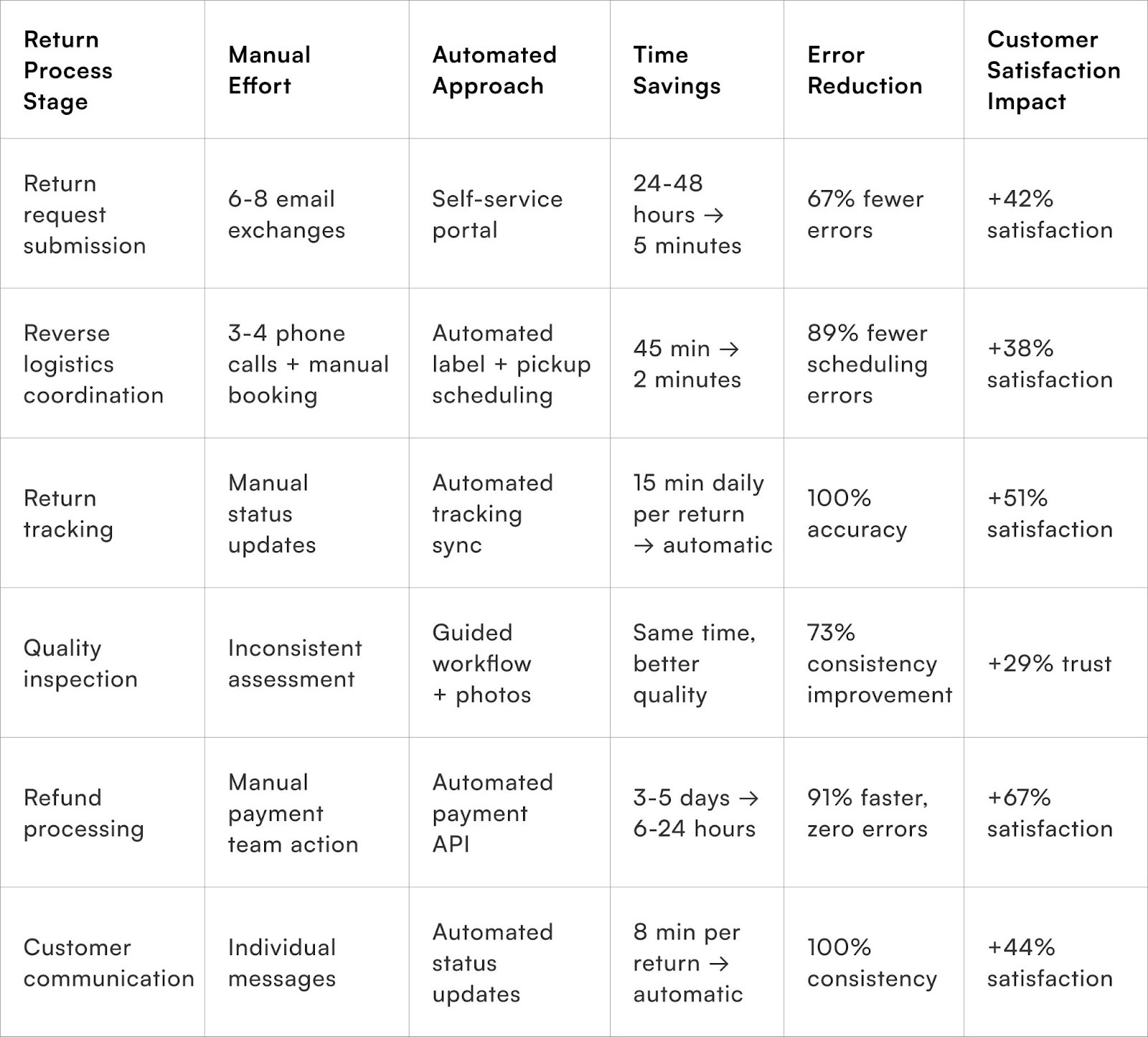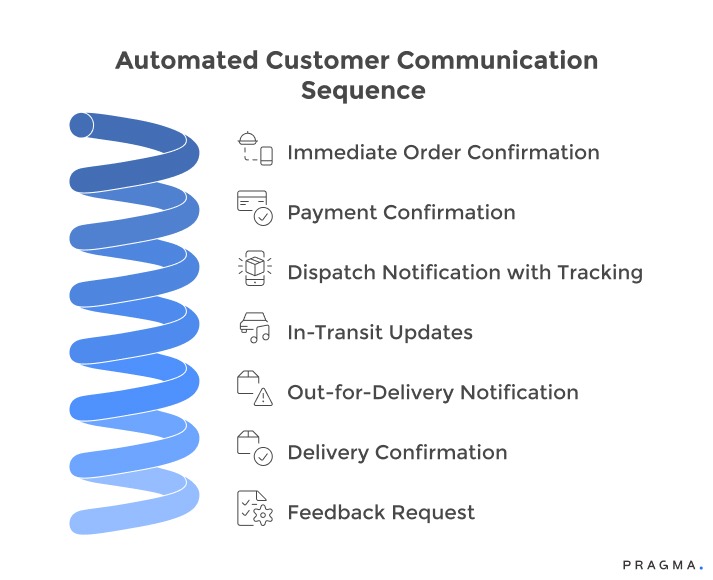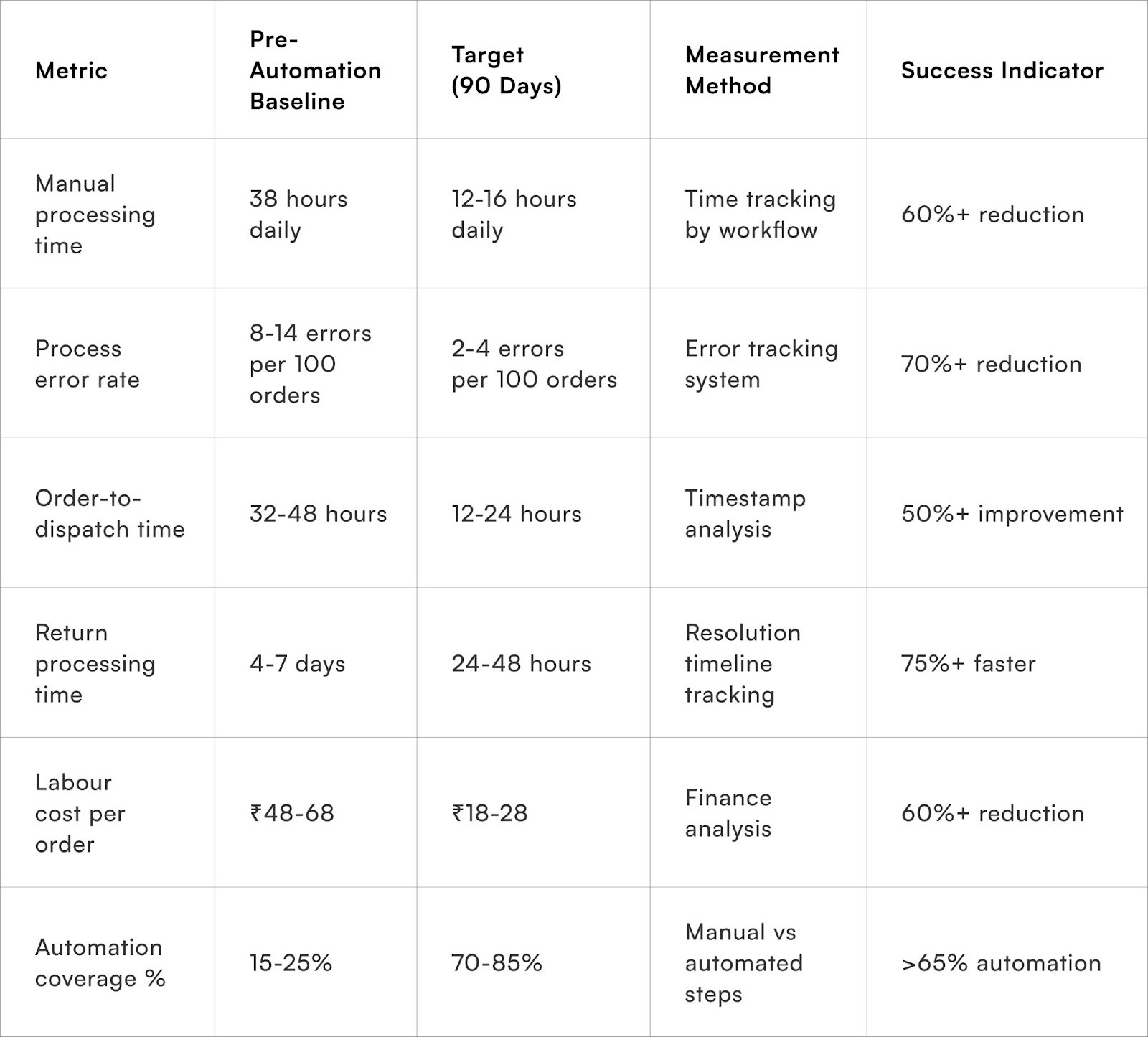Indian D2C brands are no strangers to operational headaches. COD verification calls, manual order updates, customer complaints about late refunds, and daily firefighting across support channels—these pain points can quickly drown lean teams and slow down ambitious growth. As buyer expectations soar, outdated manual processes not only erode margins but also risk damaging brand credibility with every missed delivery or delayed return.
The solution? Thoughtful automation. Modern automation playbooks allow brands to transform high-friction, repetitive tasks into reliable, self-optimising workflows. From automating COD confirmations through WhatsApp bots and instant address validation to handling returns with self-serve portals and AI-driven fraud detection, these strategies help D2C businesses save hours weekly, slash return-to-origin rates, and focus more on delighting customers.
This blog offers a practical deep dive into Automation Playbooks for D2C E-commerce: From COD to Returns. You’ll discover actionable blueprints—from setting up automated notifications and refund processing to integrating logistic partners for hassle-free pickups—that are proven to cut costs, accelerate response times, and maintain customer trust.
Whether you’re scaling up from 100 orders a day or managing complex omnichannel flows, these automation playbooks will equip your team to operate smarter, recover lost hours, and grow sustainably.
Why do partial automation implementations fail to deliver promised benefits?
Workflow fragmentation where some steps automate whilst others remain manual creates handoff friction that negates efficiency gains
Pitfalls of Incomplete Automation in D2C E-commerce

1. Disconnected Workflows and the Automation Gap:
Automating individual steps without connecting them into a continuous workflow creates a "gap" that often requires human intervention to bridge. For example, an automated order confirmation system that necessitates manual re-entry of data into separate courier, inventory, and customer service platforms triples handling rather than eliminating it.
This partial automation multiplies work due to system disjunction, failing to achieve the end-to-end continuity essential for true efficiency.
2. Absence of Automated Decision Points:
Even in otherwise automated processes, the lack of automated decision-making forces manual monitoring and intervention. Consider automated inventory syncing: if it triggers a manual review when stock falls below thresholds, instead of automatically generating purchase orders based on reorder points, it demands constant human oversight. This prevents the scalability that automation should provide. Each unautomated decision point becomes a bottleneck, where processes queue, awaiting human judgment that algorithms could handle faster and more consistently.
3. Brittle Automation and Exception Handling Gaps:
Automated workflows become operationally fragile when they cannot gracefully handle exceptions or "edge cases," leading to complete process breakdowns. For instance, an automated shipping label generator that crashes when an address lacks a pin code, rather than prompting for the missing information, forces manual intervention requiring specialized system administrator knowledge, not just operational staff capability.
This brittle automation, which fails ungracefully under variation, proves less reliable than consistent manual processes, often leading teams to bypass it entirely rather than trusting fragile systems.
4. Integration Complexity and Technical Debt:
The challenge of integrating disparate systems often creates a significant maintenance burden that erodes the value of automation over time. Connecting an order management system to courier APIs through custom code, for example, risks breaking whenever either system updates.
This demands constant technical maintenance, which small teams often cannot sustain. Technical debt accumulates until the automation degrades into unreliable workflows that teams work around rather than depend upon, ultimately reverting operations to manual processes despite initial automation infrastructure investments.
What return processing workflows benefit most from automation?
Manual return handling creates customer friction and operational bottlenecks whilst automation enables fast, consistent experiences
Return request initiation automation through self-service portals eliminates email back-and-forth currently consuming 4-6 message exchanges.
Customers access order history, select return reason from dropdown, upload product condition photos, and receive instant return approval or denial based on policy rules. The automated flow completes in 3-5 minutes what manual processing required 24-48 hours, dramatically improving customer satisfaction whilst freeing support teams from routine return administration.
Reverse logistics coordination automation generates return shipping labels, schedules courier pickups, and tracks return transit without human coordination. Upon return approval, the system automatically creates a return shipping label sent via email/WhatsApp, books pickup from customer address for next day, and monitors return transit. When return reaches the warehouse, automated notification triggers the quality inspection queue.
The seamless coordination eliminates the manual phone calls, email chains, and courier booking that previously made returns painful for customers and expensive for brands.
Quality inspection workflow automation guides warehouse staff through standardised product condition assessment whilst capturing photographic evidence. Inspection app presents product-specific checkpoints—fabric condition for apparel, functionality testing for electronics—with photo upload requirements documenting product state.
Based on assessment inputs, system automatically determines refund eligibility, restocking feasibility, or disposal necessity. The structured workflow ensures consistency whilst creating audit trail that prevents return fraud and attribution disputes.
Refund processing automation triggers payment reversals immediately upon return approval without manual finance team involvement. System integration between return approval workflow and payment gateway APIs initiates refunds to original payment method—bank accounts for UPI/cards, cash collection scheduling for COD—without manual intervention. Automated customer notifications confirm refund initiation with expected timeline, reducing "where's my refund?" support tickets by 72-79%.

What customer communication sequences should operate automatically?
Manual customer updates create inconsistent experiences whilst automated journeys ensure every customer receives timely, relevant information
Automated Communication Strategies for D2C E-commerce

1. Order Lifecycle Communication:
Automating order updates keeps customers informed at every critical milestone. This sequence typically includes:
- Immediate Order Confirmation: Acknowledging the successful placement of an order.
- Payment Confirmation: (If applicable for prepaid orders) Confirming successful payment processing.
- Dispatch Notification with Tracking: Sent within 24 hours, providing tracking details.
- In-Transit Updates: Regular notifications (every 24-48 hours) on the order's journey.
- Out-for-Delivery Notification: A morning-of alert when the order is scheduled for delivery.
- Delivery Confirmation: Confirming the successful delivery of the order.
- Feedback Request: Sent approximately 48 hours post-delivery to gather customer insights.
Each message focuses on providing essential information—current status, tracking number, and estimated delivery—avoiding excessive frequency to prevent customer annoyance.
2. Abandoned Cart Recovery:
This automation targets customers who add items to their cart but don't complete the purchase, using a timed reminder sequence to encourage conversion:
- Initial Subtle Reminder: Sent 4 hours after abandonment ("Items still in your cart").
- Incentive Offer: Escalates after 24 hours with a discount or offer ("Complete your order and save ₹75").
- Final Reminder: A last notification at 48 hours before the cart expires.
This graduated approach balances the goal of recovering sales with respecting customer boundaries, preventing an overly aggressive or intrusive experience.
3. Post-Purchase Cross-Sell:
Leveraging past purchases and order contents, this automation recommends complementary products to customers. For instance:
- A customer who purchased a kurta might receive an automated email 7 days post-delivery suggesting coordinating dupattas or accessories.
The timing allows customers to evaluate their initial purchase before being presented with additional suggestions. Recommendations based on actual purchase history are perceived as more relevant, leading to 23-29% higher response rates compared to generic promotional emails.
4. Reorder Reminders:
Designed for consumable or frequently purchased products, this automation reminds customers when it's likely time to replenish:
- A customer buying skincare products every 45-60 days would receive a reminder around the 50-day mark: "Time to restock your favourite products?"
This timing-based trigger demonstrates an understanding of customer needs and drives conversions by offering convenient reminders at optimal repurchase moments.
How can payment reconciliation automation eliminate manual accounting effort?
Manual payment matching consumes finance team hours whilst creating error risks that automation eliminates entirely
Automation streamlines financial operations for D2C e-commerce businesses by automating key reconciliation and reporting tasks.
Payment Gateway Reconciliation:
This process automates the matching of transaction records from payment gateways like Razorpay and Paytm with order management system entries. By pulling settlement reports via API and comparing transaction IDs to order numbers, it identifies discrepancies such as missing settlements or duplicate charges, flagging them for review.
This reduces daily reconciliation from hours to minutes and catches errors often missed by manual review.
COD Remittance Reconciliation:
Automation here involves comparing courier partner remittance statements against expected Cash on Delivery (COD) collections based on delivered orders. The system calculates the expected remittance (delivered COD orders minus commission charges), compares it to the actual amount received, and identifies discrepancies.
It then generates dispute reports with supporting evidence, catching underpayments or errors that manual review frequently misses due to high volume and complexity.
Commission and Fee Calculation:
This automated system eliminates error-prone spreadsheet calculations for commissions and fees from multiple courier partners, payment gateways, and marketplaces. It applies partner-specific rate cards, calculates fees based on actual transaction volumes and values, validates against partner invoices, and flags any discrepancies.
This ensures accurate expense recognition and helps identify billing errors or deviations from agreed-upon rates.
Financial Reporting Generation:
This feature automates the creation of unified P&L statements by combining data from order management, payment gateways, courier partners, and expense systems. It pulls revenue from orders, logistics costs from courier invoices, payment processing fees from gateway data, and marketing expenses from ad platforms to automatically generate weekly or monthly financial summaries.
This integrated reporting provides real-time financial visibility, replacing delayed manual reports.
What decision automation requires human oversight versus full autonomy?
Balancing automation efficiency with judgment-requiring scenarios determines where human expertise adds irreplaceable value

Fraud decisioning automation handles clear low-risk and high-risk cases whilst escalating ambiguous situations to human review. Orders scoring below 30 risk points proceed automatically. Above 70 points get automatic blocks. Scores between 30-70 trigger human review where experienced staff apply contextual judgment—customer communication quality, order explanation plausibility, profile inconsistency resolution—that algorithms cannot reliably assess.
The hybrid approach achieves 89% automation rate whilst preserving human judgment for genuinely uncertain cases.
Return approval automation approves straightforward returns meeting policy criteria whilst escalating edge cases involving significant value, customer dispute, or policy interpretation. Returns within a 15-day window for standard reasons (size, colour, quality) with condition photos showing unworn products approved automatically.
High-value returns over ₹5,000, claimed defects contradicting condition photos, or policy boundary cases escalate to customer service managers. The automation handles 78-84% of returns whilst preserving oversight for complex situations.
Supplier payment automation schedules standard payments per agreed terms whilst flagging exceptions requiring approval. Regular purchase order payments matching terms flow automatically. Payments exceeding budgets, requests for advance payment, disputes about delivery quality, or changes to payment terms require finance manager approval. The selective automation accelerates routine payments whilst ensuring oversight of transactions requiring judgment.
Customer service response automation handles FAQ and simple queries whilst escalating complex situations to human agents. Questions about tracking status, return policies, delivery timing get automated responses pulling relevant order data. Complaints about product quality, delivery problems requiring investigation, or requests involving policy exceptions escalate immediately.
The tiered response ensures instant resolution for routine queries whilst preserving human touch for sensitive situations requiring empathy and judgment.
Quick Wins
Week 1: Process Documentation and Automation Opportunity Mapping
Document current workflows for five core processes: order verification, dispatch coordination, delivery tracking updates, return request handling, and inventory reordering.
Map every step currently performed manually, calculate time spent per transaction, and identify steps amenable to automation.
Estimate potential time savings if each identified step automated. Prioritise automations by impact-to-effort ratio: high impact (saves >30 min daily), medium effort (implementable in 1-2 weeks).
Expected outcome: Prioritised automation roadmap with quantified time savings and implementation complexity assessment for top 10 opportunities.
Week 2: Quick-Win Automation Implementation
Implement three highest-impact, lowest-effort automations identified in week 1.
Common quick wins: automated order confirmation emails with tracking numbers, abandoned cart recovery email sequences, and automated courier status updates syncing to customer service system.
Use existing tools—email marketing platforms, order management system workflows, Zapier/Integromat for system connections. Test with small order volume before full deployment.
Expected outcome: Three automated workflows operational reducing 8-12 daily labour hours whilst proving automation value to team and leadership.
Week 3: Integration Infrastructure Setup
Establish API connections between core systems: order management, inventory, courier partners, payment gateways, and customer service platform.
Document API capabilities and limitations for each integration. Set up data flow for automated information sharing—orders flowing to inventory system, tracking updates populating customer service, payment confirmations updating order status. Create error handling and alert mechanisms for integration failures.
Expected outcome: Technical infrastructure enabling end-to-end automation with real-time data synchronisation across operational systems.
Week 4: Complex Workflow Automation Deployment
Implements comprehensive COD verification automation workflow: automated risk scoring at order placement, triggered OTP/call verification for medium-risk orders, automatic fraud holds for high-risk cases, and verification completion updating order status for fulfilment.
Configure decision logic thresholds based on week 1 analysis.
Train operations team on exception handling and manual review processes for escalated cases.
Expected outcome: Automated verification handling 75-85% of COD orders without manual intervention, reducing verification team workload by 18-24 hours daily.
Measuring Automation Impact

To Wrap It Up
Automation transformation succeeds through systematic workflow analysis identifying highest-impact opportunities, pragmatic implementation prioritizing quick wins over comprehensive perfection, and continuous refinement based on operational feedback. The difference between transformative automation and marginal improvement lies in end-to-end thinking that eliminates manual handoffs rather than automating isolated steps whilst preserving workflow fragmentation.
Comprehensive playbooks covering complete process sequences deliver operational leverage that piecemeal automation never achieves.
Map your five highest-volume manual workflows end-to-end documenting every step, calculate total time spent weekly, then identify which complete workflow would deliver maximum labour savings if fully automated from trigger to completion.
Sustained automation excellence requires treating workflows as living systems requiring ongoing maintenance rather than one-time implementations that remain static. Business processes evolve, systems update, and customer expectations shift, demanding regular automation refinement.
Brands establishing quarterly automation reviews examining failure rates, manual override frequencies, and new opportunity identification achieve 28-36% additional efficiency gains in year two beyond initial deployment through systematic improvement.
The compounding effect of continuous workflow optimisation creates operational scalability advantages that manual-process competitors cannot replicate regardless of team size or capital investment.
For D2C brands seeking to implement comprehensive automation across operations from COD verification through returns processing, Pragma's workflow automation platform provides pre-built playbooks for common e-commerce processes, visual workflow builders requiring no coding, integration connectors for 50+ systems, and intelligent exception handling that help brands achieve 60%+ labour cost reduction whilst improving process consistency by 70%+ through automation designed for operational teams rather than requiring technical expertise.

FAQs (Frequently Asked Questions On Automation Playbooks for D2C E-commerce: From COD to Returns)
1. How can Indian D2C brands automate COD order confirmation and reduce RTO?
Brands can integrate automated WhatsApp or SMS flows for COD order verification, use AI address validation, and incentivise prepaid payments via discounts or cashback to lower COD return rates and operational overheads.
2. What returns processes can be automated for better customer experience and reduced costs?
Key automations include self-serve return portals, automated refunds or exchange approvals, real-time status notifications, instant shipping label generation, and carrier routing for optimised reverse logistics, which all improve customer satisfaction and retention.
3. How does automation help detect and prevent e-commerce fraud in returns?
Automation tools employ behavioural analytics, scan for repeat offenders, use QR-tag or barcode validation, and flag suspicious claims, reducing policy abuse and shrinking inventory losses due to fraudulent returns.
4. Are customisable automation solutions necessary for every D2C brand?
Absolutely. Since every brand faces unique operational challenges, leading automation platforms offer configurable workflows tailored to product category, customer base, and logistical complexity, ensuring better results than generic approaches
Talk to our experts for a customised solution that can maximise your sales funnel
Book a demo




.png)